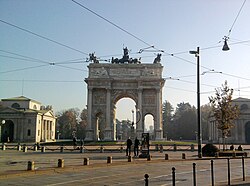Porta Sempione
| Porta Sempione | |
|---|---|
| City Gate | |

The Arch of Peace at sunset
|
|
| Coordinates: 45°28′33″N 9°10′21″E / 45.47583°N 9.17250°ECoordinates: 45°28′33″N 9°10′21″E / 45.47583°N 9.17250°E | |
| Country |
|
| Region | Lombardy |
| Province | Milan |
| Comune | Milan |
| Zone | 1 |
| Time zone | CET (UTC+1) |
| • Summer (DST) | CEST (UTC+2) |
Porta Sempione ("Simplon Gate") is a city gate of Milan, Italy. The name "Porta Sempione" is used both to refer to the gate proper and to the surrounding district ("quartiere"), a part of the Zone 1 division (the historic city centre), including the major avenue of Corso Sempione. The gate is marked by a landmark triumphal arch called Arco della Pace ("Arch of Peace"), dating back to the 19th century, although its origins can be traced back to a gate of the Roman walls of Milan.
A gate that roughly corresponds to modern Porta Sempione was already part of Roman walls of Milan. It was called "Porta Giovia" ("Jupiter's Gate") and was located at the end of modern Via San Giovanni sul Muro. At the time, the gate was meant to control an important road leading to what is now Castelseprio. Very little remains of the original Roman structure; some Roman tombstones that used to be placed by the outer side of the walls have been employed in the construction of later buildings such as the Basilica of Saint Simplician (located in Corso Garibaldi).
In the Middle Ages, part of the Roman walls in the Porta Sempione area were adapted as part of the new walls. The gate itself was moved north, in a place that is now occupied by the Sforza Castle. The Castle itself was completed in the 15th Century, under Duke Filippo Maria Visconti, and the gate itself became part of the Castle.
In 1807, under the Napoleonic rule, the Arch of Peace was built by architect Luigi Cagnola. This new gate marked the place where the new Strada del Sempione entered Milan. This road, which is still in use today, connects Milan to Paris through the Simplon Pass crossing the Alps. At the time, the gate was still called "Porta Giovia". When the Napoleonic Kingdom of Italy fell and Milan was conquered by the Austrian Empire, the gate was not yet completed, and the construction was abandoned for a while.
...
Wikipedia
